|
|
|
|
Products mentioned in this Article
--None--
|
|
|
|
|
|
|
|
|
 |
|
|
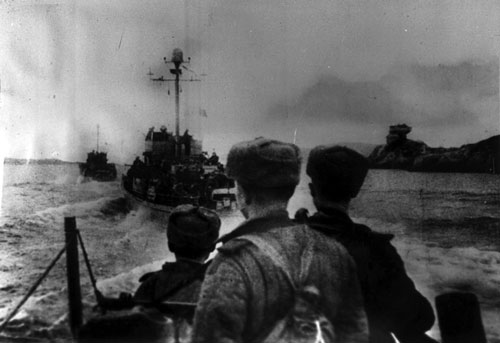 |
Objective: Festung Crimea
The Kerch-Eltigen Operation
By Rich Hamilton
In September 1943 German and Romanian forces were forced out of the Taman peninsula. The 3rd Minesweeper Flotilla was able to evacuate 200,000 men across the Kerch straits. The prize of the Caucasus oil fields were never realized, and in order to protect the Ploesti oil fields the airfields in the Crimea had to be held. It seemed certain that the first step in any Soviet assault on the Crimea would be an amphibious assault across the Kerch straits.
|
In order to defend the targeted area the 3rd Minesweeper Flotilla had lain over 2000 mines, and the German and Romanian air forces in the area tried to challenge the Soviets Air superiority. Defending the coastline was 85,000 troops in all in the form of the German 98th Infantry Division, the Romanian 6th Calvary Division and the Romanian 3rd Mountain Division. Armour support was light for the Axis forces and they would have to rely on StuG batteries to serve in this role.
|
While the area of the attack seemed obvious for both side the details of the attack were not set until just three weeks before the attack. This limited the amount of time the attacking forces had to practice for the assault. On 12 October 1943 the task was given to the North Caucasus Front under the direction of Field Marshal Timensheko. The Soviets assigned four divisions to the assault, one from the 18th Army and three from the 56th Army. One experienced battalion of marines spearheaded each assault.
|
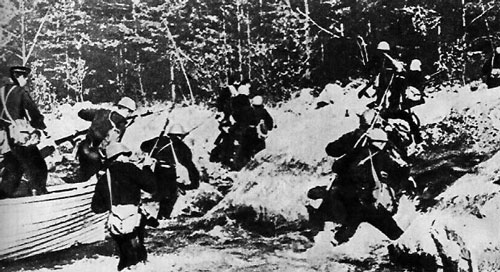 |
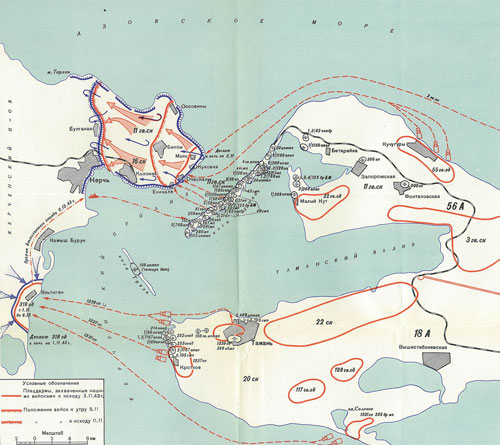 |
Admiral Kuznetsov was sent to Taman by Stalin to supervise the preparation and to work with Marshal Timensheko to coordinate the naval and ground forces. There were two main concerns for the operational planning. First winter was fast approaching and with it the probability of bad weather or that the straits could ice up, which was a problem of past operations in the area. The second concern was the lack of landing ships or craft. The Soviets simply did not have any landing ships and this problem plagued them through out the war.
Six hundred artillery guns and rocket launchers were moved into the Chushka Spit on the Taman Peninsula. This provided a large artillery force for the landing, as the port of Kerch was just five kilometres away.
|
|
On 28 October the Soviet naval forces launched an attack on the
coastline in order to fix the positions of the German artillery and
defensive positions. The assault was to be conducted that night but it
was postponed due to bad weather. The first assault took place on 31
October 1943.
Three thousand men of the 318th Rifle Division made up the first assault including 575 men of the 386th Independent Naval Infantry Battalion and the fearsome political officer Leonid Brezhnev to insure Stalin’s will was felt by all during the invasion. They embarked into hundreds of small ships of all sizes from cutters and auxiliary craft all the way down to simple rowboats.
|
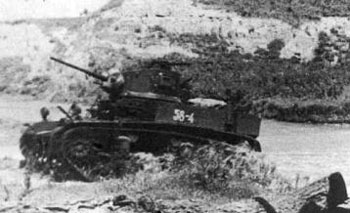 |
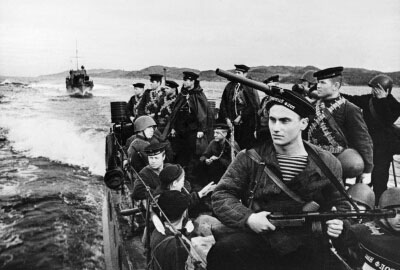 |
From five embarkation points on the Taman Peninsula they ventured out into the icy waters of the Black Sea.
The sea was rough going and the assaulting force got scattered. Some boats hit mines and others were forced to turn back such as the boat carrying the commander of 318th Rifle Division. Less than 1000 men hit the beach near the town of Eltigen.
The German defenders were literally caught with their pants down as the Soviets landed. This allowed the men of the 318th to establish a beachhead. Later that day Colonel Gladkov, commanding office of the 318th Rifle Division, made the crossing during the day to reach his men braving the bad weather and German air attacks.
|
|
The Colonel and his command staff had to wade ashore after their boat grounded on the rocky shore.
The weather remained poor and the Soviets were not able to launch the second attack until 2 November 1943. The second attack was made just north of the port city of Kerch were the German had been expecting the main attack. The 2nd Guards Rifle Division was led by the 369th Independent Marine Battalion and was able to force the beach and made several beachheads.
The landing at Eltigen had drawn away some of the German 98th Infantry Division which made the attack go more smoothly.
|
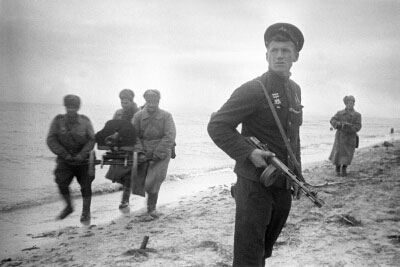 |
|
The weather had cleared and the Soviet Navy was able to successfully
navigate the straits. Eventually 75,000 troops would be ferried onto
the beaches around Kerch but first the Soviet attackers would have to
endure a difficult winter build-up.
The Eltigen beachhead did not fair as well. The Axis shifted the entire German 98th Infantry Division to Kerch to face the 2nd Guards Rifle Division. This left the Romanian 6th Calvary Division with elements of the Romanian 3rd Mountain Division to contain and eliminant the Eltigen beachhead.
|
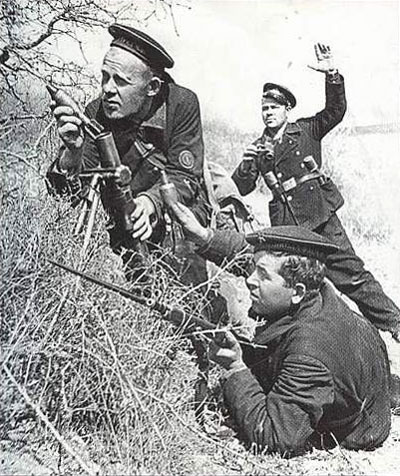 |
The Soviet 318th Rifle Division held on for just
over a month, but with the effective resistance of the German 3rd
Minesweeper Flotilla and the poor weather the Soviet Navy was not able
to keep both beachheads in good supply. On 4 December 1943 the
Romanians launched their final assault on the Soviet defenders.
The Romanians made progress against Hill 56.7 near the State Farm. At first the Soviet resistance was very heavy, but by 1530 the following day the Soviets had been pushed back to a near by lighthouse. On 6 December the Romanians managed to take the lighthouse and the town of Eltigen.
On the night of 6 December some of the remaining Soviet force managed to escape through the Romanian lines to the North. On the morning of 7 December those Soviets forces left near Eltigen surrendered to the Romanians. The last elements of the 318th held up on the Mithdrate Hill south of Kerch. The Romanians surrounded and annihilated the Soviets on 11 December.
The Soviet operation had been a success but it was a very difficult one that came at a very high cost. The Red Army would not complete their build up of the beachhead until April 1944 when the second phase of the Crimea Offensive would begin.
|
Last Updated On Monday, May 25, 2009 by Wayne at Battlefront
|
|
|